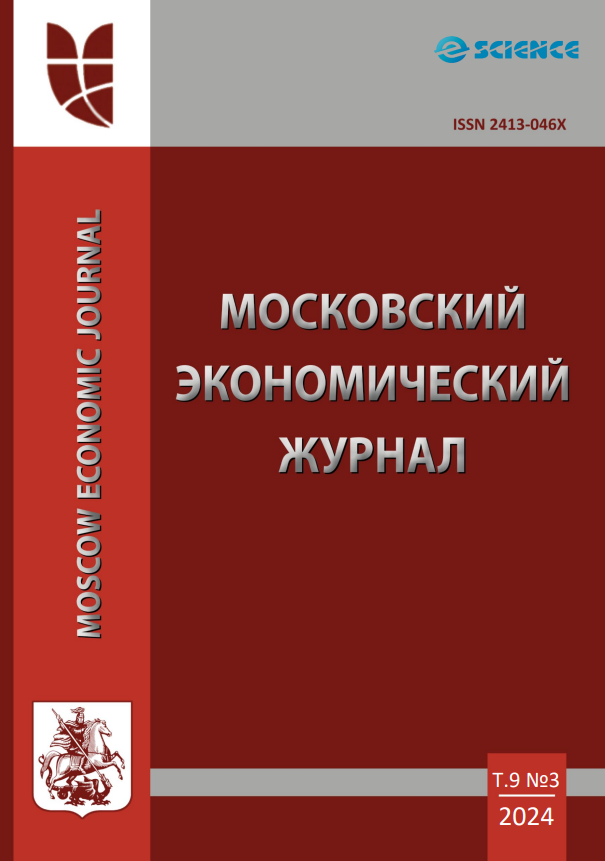UDC 502.5
UDC 502.6
The article, using the example of the territories of the Troitsky and Novomoskovsky administrative districts (hereinafter referred to as TiNAO) of Moscow, shows the possibility of a geoecological assessment of changes in the morphometric parameters of small reservoirs. Before joining the administrative structure of the Moscow territories in 2012, the studies on the ecology of these territories was minimal. Of particular importance for monitoring the geo-ecological situation in “New Moscow», – what the conjoined territories are also called, is the fact that its area is 1,480 km2, which is 57.8% of the entire territory of Moscow. The subject of the study were 1402 small reservoirs registered in the territory of the TiNAO. To carry out their environmental assessment, a cluster analysis method was used, which is a universal mathematical tool for scientific research. A negative change (decrease) in the average depth of the reservoir was taken as the main parameter of the study. Based on the results of the objects’ morphometry analysis carried out at an interval of two years, data on dynamic changes in the physical parameters of reservoirs were obtained and processed. It was established that shallowing problems exist in 4.51% of the total area of reservoirs in the TiNAO. Mapping stagnant small reservoirs made it possible to visually assess the scale of the problem and identify potentially problematic areas of the TiNAO from a geoecological point of view. Using the cluster analysis, zoning of problematic water bodies was carried out. Such identification (clustering) of water bodies’ grouping made it possible to see deviations at the level of groups of small river basins, which provided a large-scale understanding of the ecological situation at the level of catchment areas of larger water bodies.
geoecological assessment of TiNAO, small reservoirs, cluster analysis in geoecology, morphometric parameters of small reservoirs, environmental problems of the Pakhra River
1. Sanec E.V., Ovcharova E.P. Opyt geoekologicheskoy ocenki malyh gorodskih vodnyh ob'ektov (na primere goroda Minska), Institut prirodopol'zovaniya NAN Belarusi, materialy XIV Mezhdunarodnoy landshaftnoy konferencii, Minsk 2023. S. 112-115.
2. Vodnyy Kodeks Rossiyskoy Federacii ot 03.06.2006 N 74-FZ (red. ot 04.08.2023) (s izm. i dop., vstup. v silu s 01.09.2023).
3. Federal'nyy zakon «O rybolovstve i sohranenii vodnyh biologicheskih resursov» ot 20.12.2004 N 166-FZ.
4. Shaporenko S.I., Yasinskiy S.V., Vishnevskaya I.A. Izmenenie morfometricheskih parametrov vodohranilisch moskvoreckoy vodnoy sistemy za period ih ekspluatacii // Vodnoe hozyaystvo Rossii: problemy, tehnologii, upravlenie. 2014. № 1. C. 4-22.
5. Nil'sen, Frenk. Vvedenie v HPC s MPI dlya nauki o dannyh. Springer. «8. Ierarhicheskaya klasterizaciya». ISBN 978-3-319-21903-5. 2016 S. 195-211.
6. Trifonova T.A., Shutov P.S. Prostranstvennaya tipizaciya geosistem rechnyh basseynov vodosbora reki Kamy v svyazi s osobennostyami tektonicheskogo stroeniya territorii // Geodinamika i tektonofizika, 2019. №10(4) S. 1029-1044.
7. Kostenko S.A. Tehnologiya primeneniya mnogomernogo shkalirovaniya i klasternogo analiza // Fundamental'nye issledovaniya. 2012. №11. S. 927-930.
8. Kuz'menko Ya.V., Liseckiy F.N., Pichura V.I. Ocenka i prognozirovanie stoka malyh rek v usloviyah antropogennyh vozdeystviy i izmeneniy klimata // Sovremennye problemy nauki i obrazovaniya. Geograficheskie nauki. 2012. №6. - Rezhim dostupa: http://www.science-education.ru/106-7640
9. Gaydyshev I.A. Analiz i obrabotka dannyh: special'nyy spravochnik. SPb: Piter, 2001. 752 S.
10. Tushina A.S. Geoekologicheskaya ocenka malyh vodoemov goroda Novosibirska. Kandidatskaya dissertaciya. Special'nost' 25.00.36. Barnaul 2021. 251 S.
11. Zhiharev A.M., Zhihareva O.I. Uchet proyavleniya prirodno-territorial'nogo svoeobraziya pri razrabotke klassifikacii malyh rek s ispol'zovaniem metodov matematicheskogo analiza (na primere severo-vostoka Yaroslavskogo Verhnevolzh'ya) // Yaroslavskiy pedagogicheskiy vestnik 2010 S. 102-107.
12. Drabkova V. G., Sorokin I. C. Ozero i ego vodosbor - edinaya prirodnaya sistema. Leningrad: Nauka: Leningr. otd-nie. 1979. 196 S.
13. Romanov V. P. Primenenie morfometricheskih pokazateley v celyah opredeleniya prirodnogo potenciala vodoemov i prognozirovaniya ih sostoyaniya // Trudy Vsesoyuznogo soveschaniya «Antropogennye izmeneniya ekosistem malyh ozer». SPb: Gidrometeoizdat. 1991. Kn. 1. 176 S.
14. Smirnova L.G., Narozhnyaya A.G., Kozhushkov A.A. Tipizaciya vodosbornyh basseynov Belgorodskoy oblasti po morfometricheskim harakteristikam rel'efa dlya ocenki erozionnoy opasnosti na regional'nom urovne // Dostizheniya nauki i tehniki APK. 2015 T.29. №12. S. 66-91.
15. Nikitenkov A.N., Dutova E.M. Rechnoy stok i morfometricheskie parametry vodosborov severnoy chasti Kuzneckogo Alatau // Izvestiya Tomskogo politehnicheskogo universiteta. Inzhiniring georesursov 2010 T.136. №1. S. 142-147.
16. Gosudarstvennyy vodnyy reestr : [arh. 15 oktyabrya 2013] / Minprirody Rossii. 2009.
17. Vagner B. B., Klevkova I. V. Reki Moskovskogo regiona. Uchebno-spravochnoe posobie po kursu «Geografiya i ekologiya Moskovskogo regiona» M.: MGPU, 2003. 73 S.











